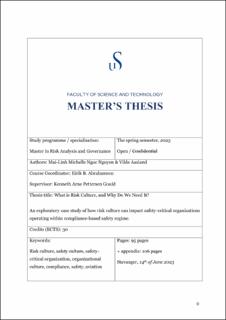| dc.description.abstract | Hybrid threats dominate our contemporary and technological society, and new risks can be challenging to predict because of today’s digitization. As modern safety-critical organizations and their technologies become more complex, similar to the digitalization experienced in today’s society, they become more susceptible to accidents resulting from unforeseen events. Thus, the importance of a sound and functional safety culture is deemed important. This thesis seeks to shed light on risk culture in safety-critical organizations, and whether focusing on risk culture could have a positive impact on safety culture and, subsequently, safety. Therefore, the problem statement of this thesis is:
In what way can a sound risk culture improve an already existing safety culture in safety-critical organizations operating within compliance-based safety regimes?
A qualitative research method, consisting of an exploratory case study, was used to help answer the problem statement. This included interviews with the case organization, as well as document analysis of both internal and external documents. In total, 18 semi-structured interviews with informants from different levels within the organization were conducted. After the interviews, the informants were provided with a statement form as a part of the interviews. Here, they were asked to rank eight statements from 1 to 5 as to whether they agreed or disagreed. The document analysis consisted of five internal documents and one external.
While no organization can completely eliminate all risks, an emphasis on risk culture involves having a proactive and systematic approach to identifying, assessing, and managing risks. This could, in turn, ensure that decisions made are more likely to be the same, independently of the decision-maker. The findings of this thesis indicate that an emphasis on risk culture, as a component within safety culture, could have a positive impact and thus improve safety.
We observed that there was a lack of a collective understanding of what risk, risk culture, and risk-based approach are, within the organization. An increased understanding of risk culture among individuals can contribute to a better systems-based understanding of how all tasks are interrelated and, thus, enhance awareness of the risks the employees may encounter in their workday. Consequently, emphasizing risk culture in light of their safety culture could have a positive influence on the existing safety culture, thus improving the level of safety. | |
